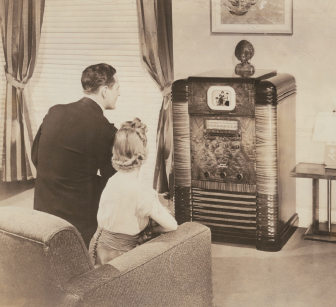The Electronic and Digital Eras
Printed Page 8

In Europe and America, the rise of industry completely transformed everyday life: Factories replaced farms as the main centers of work and production. During the 1880s, roughly 80 percent of Americans lived on farms and in small towns; by the 1920s and 1930s, most had moved to urban areas, where new industries and economic opportunities beckoned. This shift set the stage for the final two eras in mass communication: the electronic era (whose key innovations included the telegraph and television) and the digital era (whose flagship invention is the Internet).
The Electronic Era
In America, the gradual transformation from an industrial, print-based society to one fueled by electronic innovation began with the development of the telegraph in the 1840s. Featuring dot-dash electronic signals, the telegraph made media messages instantaneous—unencumbered by stagecoaches, ships, or the pony express.2 It also enabled military, business, and political leaders to coordinate commercial and military operations more easily than ever. And it laid the groundwork for future technological developments, such as wireless telegraphy, the fax machine, and the cell phone (all of which ultimately led to the telegraph’s demise).
The development of film at the start of the twentieth century and radio in the 1920s were important milestones. But the electronic era really took off in the 1950s and 1960s, with the arrival of television—a medium that powerfully reshaped American life.
The Digital Era
With the arrival of cutting-edge communication gadgetry—ever smaller personal computers, cable TV, e-mail, DVDs, DVRs, direct broadcast satellites, cell phones, PDAs—the electronic era gave way to the digital era. In digital communication, images, texts, and sounds are converted (encoded) into electronic signals (represented as combinations of ones and zeros) that are then reassembled (decoded) as a precise reproduction of, say, a TV picture, a magazine article, a song, or a voice on the telephone. On the Internet, various images, text, and sounds are all digitally reproduced and transmitted globally.
New technologies, particularly cable television and the Internet, have developed so quickly that those who had long controlled the dispersal of information—for example, newspaper editors and network television news producers—have lost some of that power. Moreover, e-mail and text messages—digital versions of both oral and written culture—now perform some of the functions of the postal service and are outpacing some governments’ attempts to control communications beyond national borders.